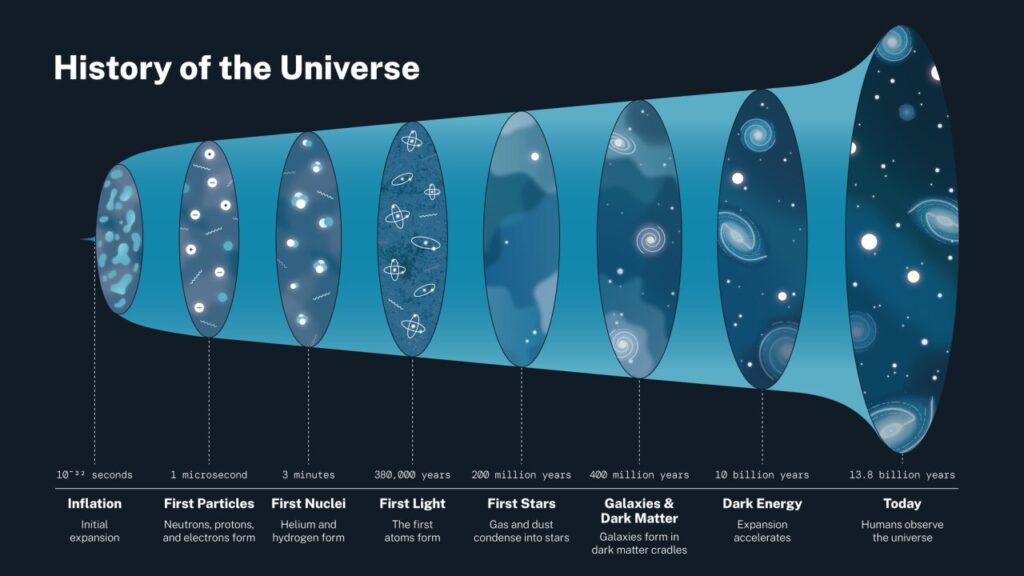
The universe, with its birth, growth, and eventual fate, has long captivated the human imagination. Recent findings from the South Pole Telescope are now offering fresh insights into the mysterious force known as dark energy, potentially reshaping our understanding of the cosmos. This groundbreaking research, released after two years of meticulous mapping of the early universe, suggests that dark energy may be evolving over time, challenging existing cosmological models.
Our current understanding of the universe’s origins is rooted in the “hot Big Bang” theory, which posits that the universe began approximately 13.8 billion years ago. This primordial event set the stage for cosmic inflation, a rapid expansion that outpaced the speed of light for a brief moment. As the universe cooled, it transitioned from a super-heated plasma to a more stable state, eventually forming atoms and the cosmic microwave background (CMB) radiation, a relic from 400,000 years after the Big Bang.
Understanding Dark Energy
Dark energy, which constitutes nearly 70% of the universe, has puzzled scientists since its discovery in 1998. Unlike ordinary matter and dark matter, dark energy exerts a repulsive gravitational force, accelerating the universe’s expansion. The simplest explanation for this phenomenon has been Einstein’s cosmological constant, a concept he introduced to maintain a static universe before retracting it following Edwin Hubble’s revelation of the universe’s expansion.
The South Pole Telescope’s recent observations, combined with data from the Dark Energy Spectroscopic Instrument (DESI), suggest that dark energy may not be constant after all. Instead, it appears to be weakening over time, a finding that could have profound implications for our understanding of the universe’s future.
New Observations and Their Implications
Located at the Amundsen-Scott South Pole Station in Antarctica, the South Pole Telescope is equipped with 16,000 detectors sensitive to millimeter-wavelength light. This sophisticated instrument has enabled researchers to make precise measurements of temperature and polarization patterns in the CMB, offering new insights into the distribution of matter in the early universe.
The research team combined these observations with DESI’s 3D galaxy distribution data, revealing a potential shift in dark energy’s behavior. If these findings hold true, they could necessitate a revision of the Lambda-CDM model, the current best model for cosmic evolution, which relies heavily on the cosmological constant.
Expert Opinions and Future Research
According to experts, the implications of evolving dark energy are significant. “If dark energy is indeed changing, it could mean that our understanding of the universe’s expansion is incomplete,” said Dr. Emily Thompson, a cosmologist at the University of California. “This could lead to new physics beyond Einstein’s theory of general relativity.”
While the current evidence is compelling, it has not yet reached the gold standard of scientific certainty, known as 5 sigma, or less than a 1 in 3.5 million chance of being false. Future experiments, such as the upgraded DESI-2 and the forthcoming CMB-S4, aim to gather more data to confirm these findings.
Looking Ahead
As the scientific community eagerly anticipates further results, the potential for a paradigm shift in cosmology looms large. An upgraded receiver is set to be installed on the South Pole Telescope in 2028, and the Simons Observatory is expected to begin survey observations soon. These advancements, coupled with ongoing research, could eventually provide the evidence needed to determine whether the universe’s accelerating expansion is indeed losing momentum.
The quest to understand dark energy and its role in the universe’s evolution continues to inspire scientists worldwide. As new data emerges, the potential for groundbreaking discoveries remains, promising to deepen our understanding of the cosmos and its myriad mysteries.





